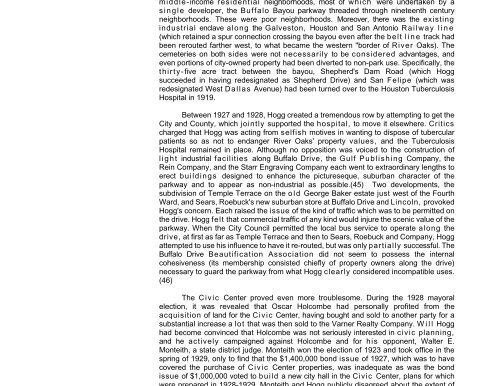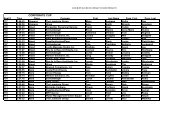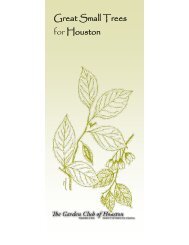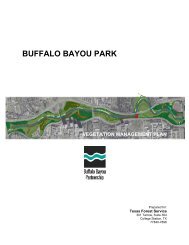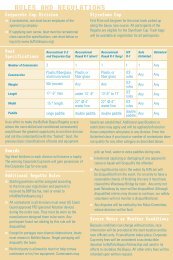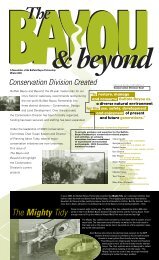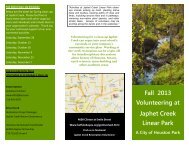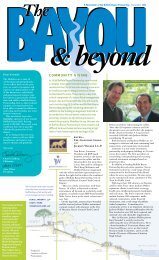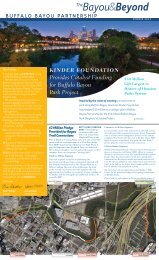History of the Shepherd to Sabine project area - Buffalo Bayou Park
History of the Shepherd to Sabine project area - Buffalo Bayou Park
History of the Shepherd to Sabine project area - Buffalo Bayou Park
You also want an ePaper? Increase the reach of your titles
YUMPU automatically turns print PDFs into web optimized ePapers that Google loves.
middle-income residential neighborhoods, most <strong>of</strong> which were undertaken by as i n g l e developer, <strong>the</strong> <strong>Buffalo</strong> <strong>Bayou</strong> parkway threaded through nineteenth centuryneighborhoods. These were poor neighborhoods. Moreover, <strong>the</strong>re was <strong>the</strong> existingindustrial enclave along <strong>the</strong> Galves<strong>to</strong>n, Hous<strong>to</strong>n and San An<strong>to</strong>nio R a i l w a y l i n e(which retained a spur connection crossing <strong>the</strong> bayou even after <strong>the</strong> belt l i n e track hadbeen rerouted far<strong>the</strong>r west, <strong>to</strong> what became <strong>the</strong> western "border <strong>of</strong> River Oaks). Thecemeteries on both sides were not necessarily <strong>to</strong> be considered advantages, andeven portions <strong>of</strong> city-owned property had been diverted <strong>to</strong> non-park use. Specifically, <strong>the</strong>thirty-five acre tract between <strong>the</strong> bayou, <strong>Shepherd</strong>'s Dam Road (which Hoggsucceeded in having redesignated as <strong>Shepherd</strong> Drive) and San Felipe (which wasredesignated West Dallas Avenue) had been turned over <strong>to</strong> <strong>the</strong> Hous<strong>to</strong>n TuberculosisHospital in 1919.Between 1927 and 1928, Hogg created a tremendous row by attempting <strong>to</strong> get <strong>the</strong>City and County, which jointly supported <strong>the</strong> hospital, <strong>to</strong> move it elsewhere. Criticscharged that Hogg was acting from selfish motives in wanting <strong>to</strong> dispose <strong>of</strong> tubercularpatients so as not <strong>to</strong> endanger River Oaks' property values, and <strong>the</strong> TuberculosisHospital remained in place. Although no opposition was voiced <strong>to</strong> <strong>the</strong> construction <strong>of</strong>l i g h t industrial facilities along <strong>Buffalo</strong> Drive, <strong>the</strong> Gulf Publishing Company, <strong>the</strong>Rein Company, and <strong>the</strong> Starr Engraving Company each went <strong>to</strong> extraordinary lengths <strong>to</strong>erect buildings designed <strong>to</strong> enhance <strong>the</strong> pictureseque, suburban character <strong>of</strong> <strong>the</strong>parkway and <strong>to</strong> appear as non-industrial as possible.(45) Two developments, <strong>the</strong>subdivision <strong>of</strong> Temple Terrace on <strong>the</strong> o l d George Baker estate just west <strong>of</strong> <strong>the</strong> FourthWard, and Sears, Roebuck's new suburban s<strong>to</strong>re at <strong>Buffalo</strong> Drive and Lincoln, provokedHogg's concern. Each raised <strong>the</strong> issue <strong>of</strong> <strong>the</strong> kind <strong>of</strong> traffic which was <strong>to</strong> be permitted on<strong>the</strong> drive. Hogg felt that commercial traffic <strong>of</strong> any kind would injure <strong>the</strong> scenic value <strong>of</strong> <strong>the</strong>parkway. When <strong>the</strong> City Council permitted <strong>the</strong> local bus service <strong>to</strong> operate along <strong>the</strong>drive, at first as far as Temple Terrace and <strong>the</strong>n <strong>to</strong> Sears, Roebuck and Company, Hoggattempted <strong>to</strong> use his influence <strong>to</strong> have it re-routed, but was only partially successful. The<strong>Buffalo</strong> Drive Beautification Association did not seem <strong>to</strong> possess <strong>the</strong> internalcohesiveness (its membership consisted chiefly <strong>of</strong> property owners along <strong>the</strong> drive)necessary <strong>to</strong> guard <strong>the</strong> parkway from what Hogg clearly considered incompatible uses.(46)The Civic Center proved even more troublesome. During <strong>the</strong> 1928 mayoralelection, it was revealed that Oscar Holcombe had personally pr<strong>of</strong>ited from <strong>the</strong>acquisition <strong>of</strong> land for <strong>the</strong> Civic Center, having bought and sold <strong>to</strong> ano<strong>the</strong>r party for asubstantial increase a lot that was <strong>the</strong>n sold <strong>to</strong> <strong>the</strong> Varner Realty Company. W i l l Hogghad become convinced that Holcombe was not seriously interested in civic planning,and he actively campaigned against Holcombe and for his opponent, Walter E.Monteith, a state district judge. Monteith won <strong>the</strong> election <strong>of</strong> 1923 and <strong>to</strong>ok <strong>of</strong>fice in <strong>the</strong>spring <strong>of</strong> 1929, only <strong>to</strong> find that <strong>the</strong> $1,400,000 bond issue <strong>of</strong> 1927, which was <strong>to</strong> havecovered <strong>the</strong> purchase <strong>of</strong> Civic Center properties, was inadequate as was <strong>the</strong> bondissue <strong>of</strong> $1,000,000 voted <strong>to</strong> build a new city hall in <strong>the</strong> Civic Center, plans for which


